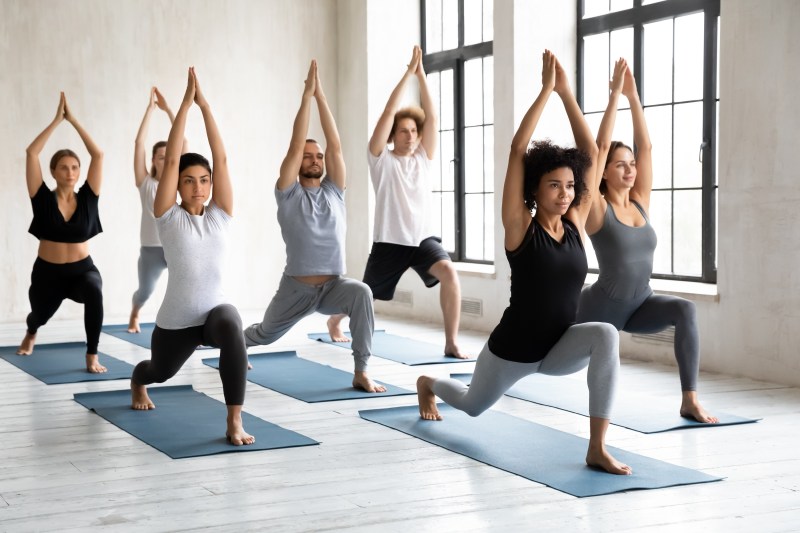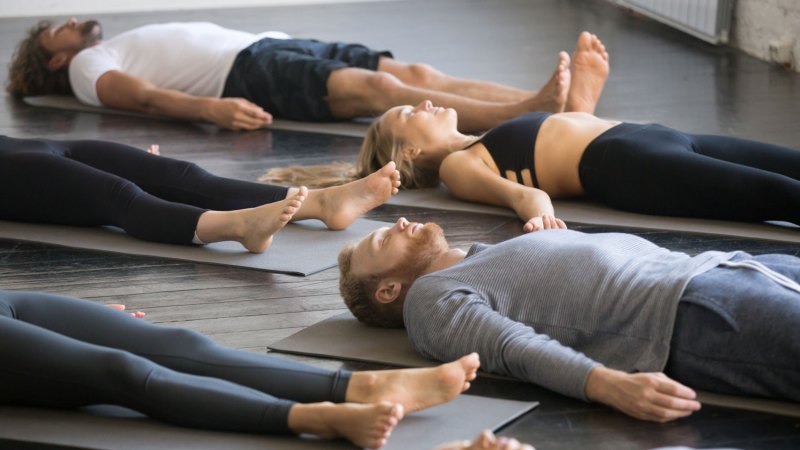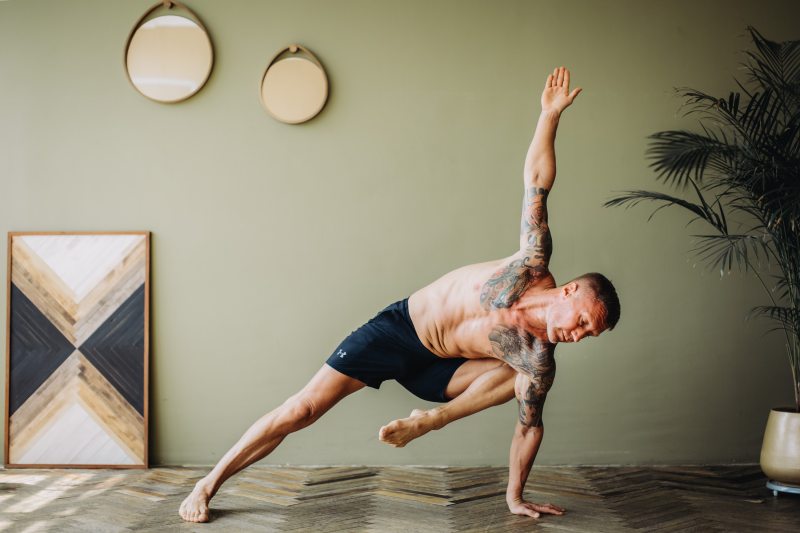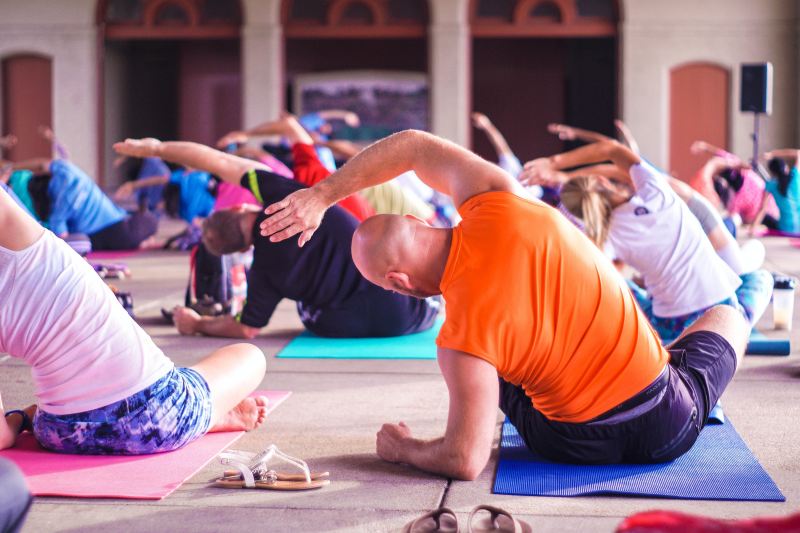
Stress levels can skyrocket as the holiday season sweeps in with its frenzy of family gatherings, company potlucks, and alcohol-infused festivities. This winter, practice hot yoga to stay lean, practice mindfulness, and reduce stress. Whether you want to sweat out that extra cocktail from your last holiday party or you want to improve your flexibility over time, hot yoga can help.
In this article, we’ll explore how practicing hot yoga can be a great way to relieve stress, increase flexibility, strengthen muscles, boost focus, and recharge your energy during the holidays. Get ready to discover how yoga can transform the winter blues into a season of zen and vitality.

What is hot yoga?
A hot yoga class is yoga performed in a temperature-controlled, humid environment, usually set between 95 and 100 degrees Fahrenheit. By increasing sweat output and enhancing flexibility, hot yoga promotes cleansing and rejuvenation during the colder months.
In addition to enhancing self-awareness and improving mood, yoga, including hot yoga, falls under the broader category of mindfulness practices. The state of mindfulness is achieved by focusing our awareness on the present moment while accepting our feelings, thoughts, and bodily sensations without judgment. Hot yoga is a great way to practice mindfulness, as it encourages mindful breathing and being present in the moment.
Studies reveal its potential to reduce symptoms of anxiety and depression and elevate overall well-being. Although the precise mechanisms at play remain a mystery, research suggests that mindfulness may dampen the body’s stress response, offering a plausible explanation for the relief it brings to those who partake in this holistic practice. Therefore, you should consider engaging in hot yoga this winter, not only for its warmth but also for its many health benefits.

What are the benefits of hot yoga?
Hot yoga benefits go beyond the already well-established benefits of traditional yoga. In addition to promoting mental and physical well-being, engaging in hot yoga can be a transformative experience, enhancing not only your mental and physical health but also contributing significantly to your overall fitness journey.
Increase flexibility
Yoga offers numerous benefits to both the body and the mind. One of its key advantages is its ability to promote muscle relaxation and release tension stored within the body. When additional heat is added, as with hot yoga, stretching and lengthening muscles become easier. By doing this, tightness is diminished, posture is improved, and pain is reduced as a result. Increasing one’s flexibility can also help prevent injuries and improve one’s performance as an athlete.
Improved heart health
Yoga is beneficial for the heart because it increases your heart rate and helps to strengthen the cardiovascular system. Hot yoga can improve blood circulation, lower blood pressure, and reduce stress levels. The additional heat requires your body to work harder, resulting in an increased heart rate and increased cardiovascular strength over time. Additionally, hot yoga helps to improve oxygen delivery to the brain, which can improve cognitive function and mental clarity.
Burn more calories
In a hot yoga session, the extra heat contributes to an increase in metabolism, which results in a greater expenditure of calories. The result may help you shed a few pounds. As well as burning calories, hot yoga improves blood circulation and may alleviate inflammation within the body. Hot yoga can enhance blood flow to muscles and organs, allowing oxygen and nutrients to be transported more efficiently. In addition, reducing inflammation can offer relief to those with chronic diseases and improve overall health and quality of life.
Improved mood
Winter brings chilly temperatures, which makes hot yoga a rejuvenating and soul-warming activity. By cranking up the heat, this unique practice adds an extra layer of intensity to mindfulness, enhancing its transformative power. Research findings demonstrate hot yoga’s remarkable capacity to soothe anxiety levels, particularly in those navigating high-stress daily routines, and to improve emotional regulation. It offers a respite from the seasonal chill and a path to serenity with each new pose you flow into.
Having explored the many benefits of hot yoga, let’s consider how you can incorporate this transformative practice into your daily routine, even from home.

Can you do hot yoga at home?
You can practice hot yoga without going to a yoga studio. In fact, hot yoga can be practiced in the comfort of your own home. Heat can be infused into your practice more easily than you might think. Make a cozy yoga corner in their homes by transforming a space with space heaters. Or prepare for an at-home hot yoga session with a warm cup of tea or a soothing beverage to warm the body up. A bath or shower can also help relax those muscles, allowing them to stretch and bend more easily during your practice.
Make sure to stay hydrated before and after your session. Stretch before and after your session to warm up your muscles and prevent any injuries. Finish your practice with a calming meditation to bring peace and relaxation to your day.
Yoga offers a holistic approach to winter well-being, providing warmth, stress relief, immune system support, mood enhancement, flexibility, balance, mindfulness, and a convenient indoor exercise option. In the colder months, this versatile practice helps individuals regain equilibrium and find inner peace. Hot yoga, in particular, combines physical warmth with mental serenity, enhancing these benefits. During winter’s chill, consider giving hot yoga a try if you’re seeking warmth and tranquility.



